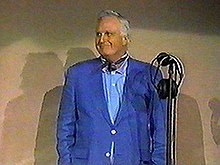Bill Wendell
| Bill Wendell | |
|---|---|

Bill Wendell's last appearance on the Late Show with David Letterman (August 18, 1995).
|
|
| Born |
William Joseph Wenzel, Jr. March 22, 1924 New York City, U.S. |
| Died | April 14, 1999 (aged 75) Boca Raton, Florida, U.S. |
| Occupation | Announcer |
| Years active | 1950s – 1995 |
William Joseph Wenzel, Jr. (March 22, 1924 – April 14, 1999), known as Bill Wendell, was an NBC television staff announcer for almost his entire professional career.
Born in New York City, Wendell served in the United States Army Air Corps during World War II and graduated from Fordham University with a degree in speech. He began his radio career in summer of 1947 at WHAM in Rochester, New York. He moved to WWJ Detroit where he worked in both radio and TV. Wendell returned to Manhattan in 1952 when he landed a job on the DuMont television network emceeing several shows before jumping to NBC in 1955.
He was a regular on the 1955-1956 version of The Ernie Kovacs Show, serving as the show's announcer, as well as a participant in sketches such as "Mr. Question Man" (a parody of The Answer Man). He also worked with Steve Allen, Jack Paar, Dave Garroway and other NBC personalities.
On October 13, 1958, Wendell succeeded Jack Barry (who was implicated in the quiz-show scandals) as emcee of Tic Tac Dough, until it was finally cancelled in October the following year and by December, had resumed his staff announcing position at NBC, forming part of a fraternity of network staff announcers who held lifetime contracts; his colleagues were Don Pardo, Wayne Howell, Fred Facey, Bill McCord, Roger Tuttle and Howard Reig.
During the 1970s, Wendell succeeded Johnny Olson as the announcer of the syndicated To Tell the Truth from 1972–1977, after Olson left New York City to assume the job on CBS's game The New Price Is Right, based in Southern California. Wendell was also announcer for several years on the Macy's Thanksgiving Day Parade. In addition, during the years when the television networks didn't broadcast 24 hours a day, Wendell anchored a five-minute summary of the day's news—the last program NBC would air before local affiliates would sign off—on which he was heard but not seen as a network hand displayed still images or illustrations related to the brief news items.
...
Wikipedia
